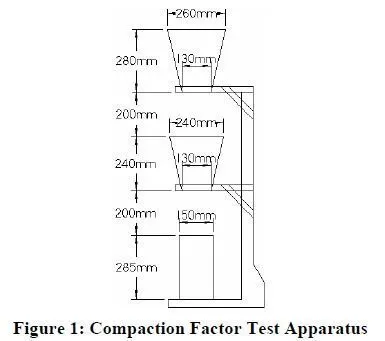The Vebe consistometer (Bartos 1992; Scanlon 1994; Bartos, Sonebi, and Tamimi 2002)
measures the remolding ability of concrete under vibration. The test results reflect the amount of energy required to remold a quantity of concrete under given vibration conditions. The Vebe consistometer is applicable to concrete with slumps less than 2 inches.
The apparatus, shown in Figure 10, consists of a metal cylindrical container mounted on a vibrating table, which produces a sinusoidal vibration. In the version of the test standardized in Europe as EN 12350-3, a slump cone is placed in the center of the cylinder and filled in the same manner as in the standard slump test. After the slump cone is removed, a clear plastic disk is set atop the fresh concrete. The Vebe table is started and the time for the concrete to remold from
the slump cone shape to the shape of the outer cylindrical container is recorded as a measure of consistency. The sliding clear plastic disk facilitates the determination of the end of the test.

Juvas (1994) has presented a modified Vebe test to more efficiently measure low slump
concretes that exhibit standard Vebe times greater than 30 seconds. In the modified Vebe test, a 20 kg surcharge is attached to the rod above the clear plastic disk. The remainder of the test apparatus and procedure is unchanged. The modified Vebe test more closely represents the production of precast concrete elements that are both vibrated and pressed.
ASTM C1170 describes two variations on the procedure described above for use with rollercompacted concrete. Instead of placing concrete in a slump cone in the cylinder, concrete is
placed directly into the 9 ½-inch diameter, 7 ¾-inch tall cylinder without compaction. For Test Method A, a 50 pound surcharge is placed on the sliding plastic disk. The vibrator is started and the time for the concrete to consolidate and a mortar ring to form around the plastic disk is recorded. The surcharge is then removed and the concrete is vibrated further until the total vibration time is 2 minutes. The density of the consolidated concrete in the mold is then determined. When the Vebe time by Test Method A is less than 5 seconds, Test Method B
should be used. In Test Method B, the surcharge is not used. Both the time for a mortar ring to
form around the perimeter of the cylinder and the final density of the compacted concrete arerecorded. Both methods are applicable for concretes with maximum aggregate sizes up to 2 inches. A minimum of 50 pounds of concrete is required for each test method.
Since the test apparatus is large and heavy, it is inappropriate for field use. The vibrating table must be mounted on a large and stable base of sufficient mass to absorb the tables vibrations.
The main use for the test has been in the laboratory and in the precast industry, where low slump concrete mixes are commonly used (Bartos 1992). The apparatus is neither directly related to slump nor plastic viscosity.
Advantages:
The Vebe consistometer is a dynamic test and can be used on concretes that are too dry for the slump test.
The test device is standardized in ASTM and identified by ACI Committee 211 (2002) in its guide for proportioning low slump concrete.
Test results are obtained directly.
Disadvantages:
Due to the need to ensure that all vibration is kept within the test device, the size of the test device makes the Vebe consistometer generally unsuitable for field use.
The test device only works for low slump concretes.
No analytical treatment of the test method has been developed. Such treatment would be complex because the shear rate declines during the duration of the test as the concrete specimen changes shape.

do you have a lab sheet for vebe consistometer???
please help me..i’m student from mlysia…